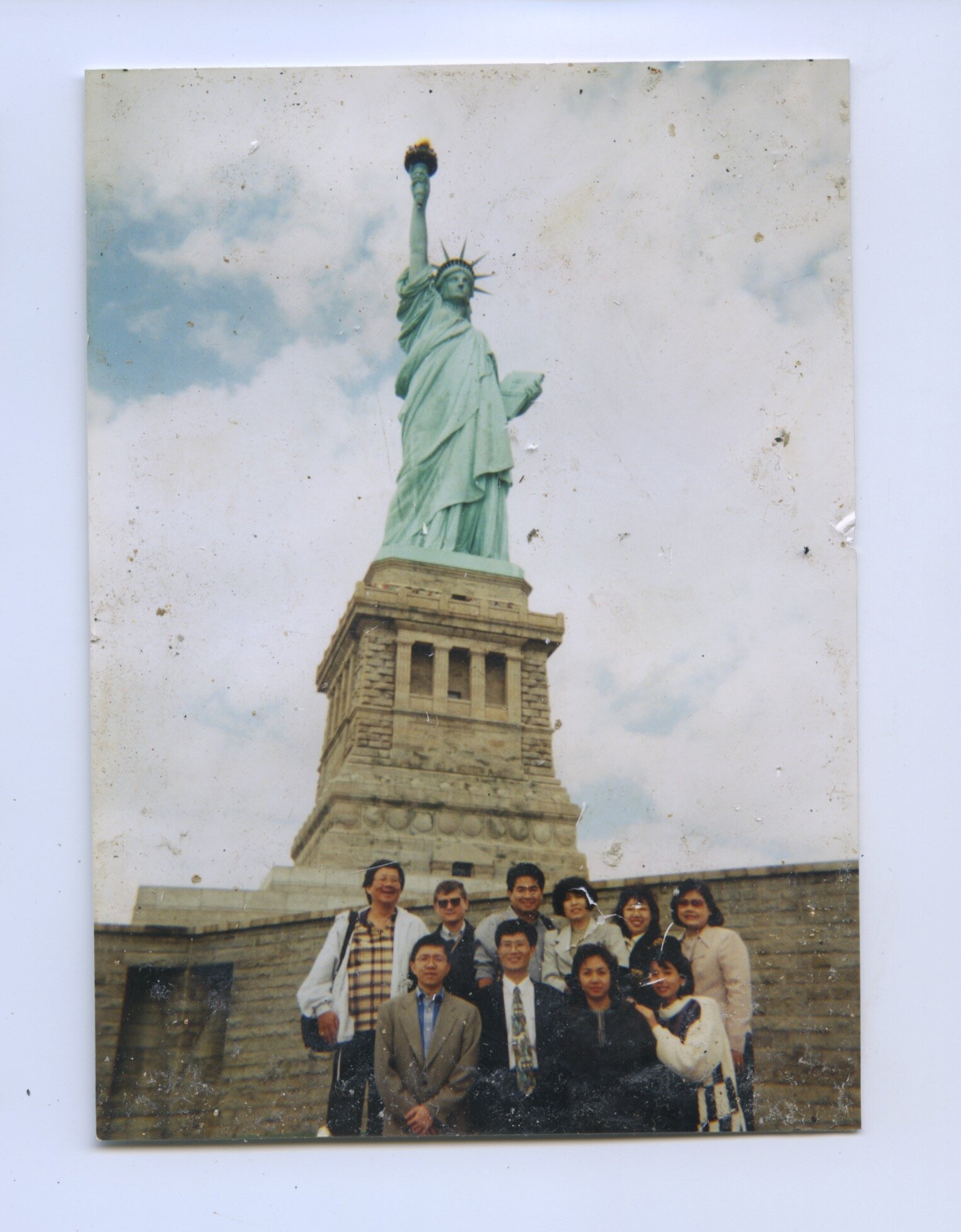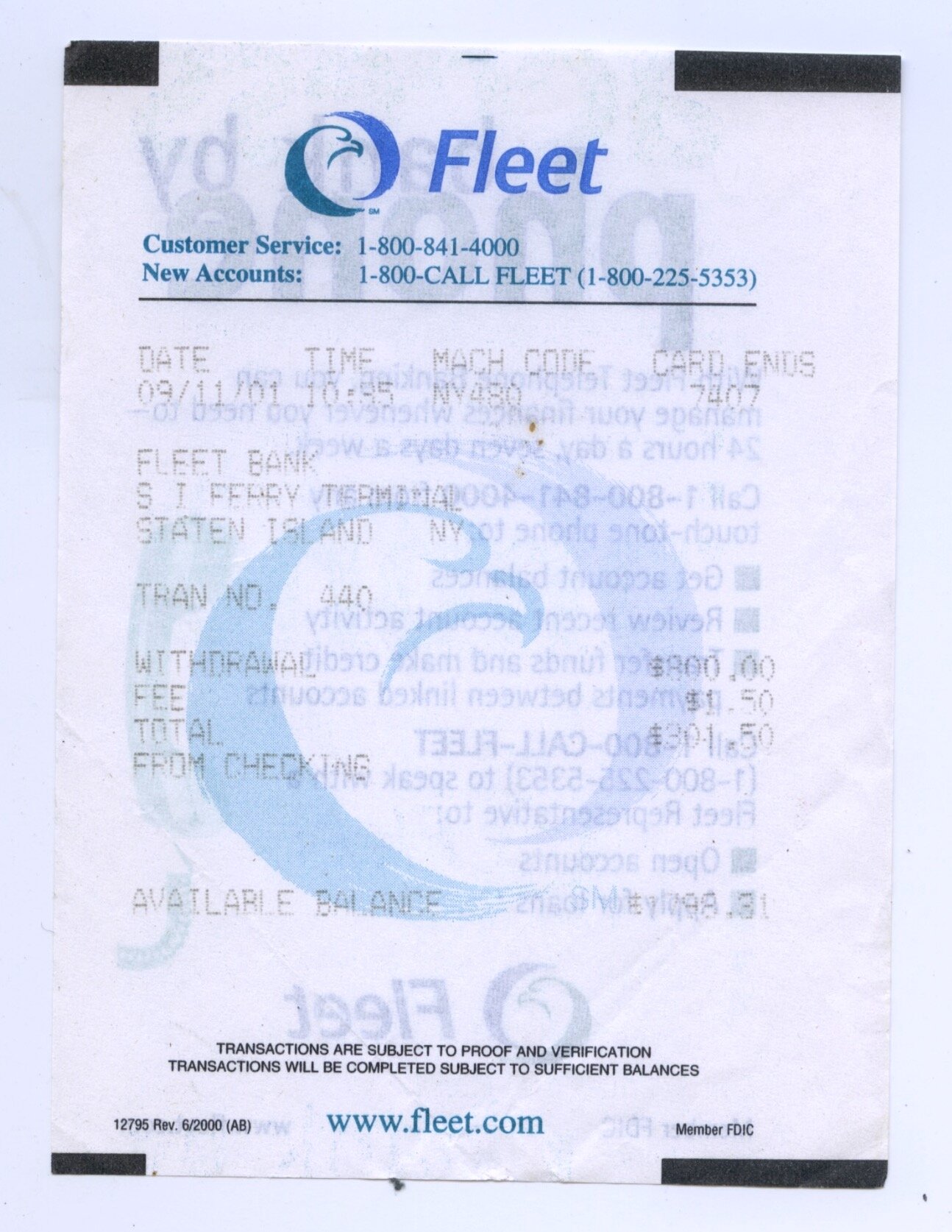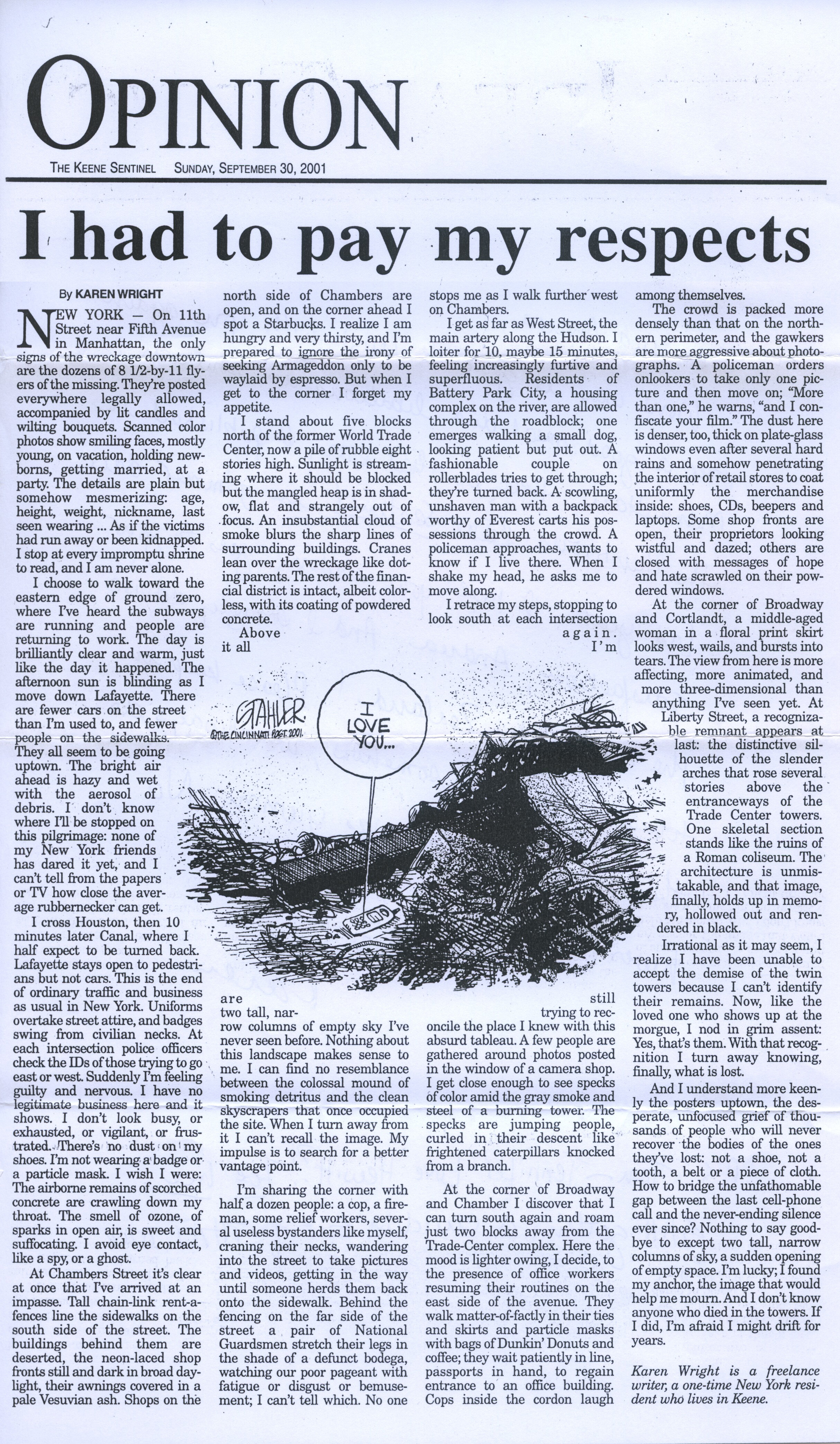Listen to Los Angeles Poet Laureate Lynne Thompson read Andrea Carter Brown's poem "The Rock in the Glen" from her new poetry collection September 12 for the 20th anniversary of 9/11, Los Angeles Public Library Podcast 25, Sept. 15, 2001
Copy of The New York Times dated September 11, 2001, left open on a table when I fled.
The morning of 9/11, I was sitting in my apartment a block from the World Trade Center drinking coffee and reading the paper. Shortly after the North Tower was hit, I fled on foot and, by a circuitous route through Staten Island, New Jersey, and Rockland County, was reunited that night with my husband in Westchester. Four days later we returned to our apartment under armed guard to retrieve important papers. Six months later, when we were allowed to move back, there was still no phone service or transit or any stores within a mile. Tourists gawked at us as we tried to go about our lives.
That is the short story of my experience of 9/11.
But the truth is, the details of that day are indelibly etched in my memory. Many are still as vivid as they were then. Some are finding their way to the surface to this day.
When other people started writing about what they had witnessed, I realized that my perspective, and hence my memories, were completely different from what was being reported in the media or described by other writers. For example, having taken a different escape route, I didn’t see the iconic images of the towers on fire: I saw them instead from the west and south, initially from my living room window and then from nearby streets. When the first tower fell, I was in a berthed Staten Island Ferry. The world went black, but I had no idea what had happened.
Although it was months before I could write anything about that day, I felt very early on that my story, a domestic odyssey prompted by a terrorist attack, unique in its own way, needed to be told. Later I learned the small New Jersey town where I grew up lost 10 residents that morning, which was one of the highest victim counts among the surrounding suburban towns. The layers of grief kept rippling outward. As they do to this day. I wanted to honor those memories and that grief.
This body of work has continued to grow: from a single sonnet crown, to a narrative sequence of double sonnet crowns interspersed with half-sonnets about the victims from my old home town, to an extended sequence of prose poems, to step-out lyrical, found, and concrete poems. It continues to grow because, of course, that day is still present for those of us who were there.
Will I ever stop? Probably not. At one time I hoped the project would be finished, I longed for it to end, but now I realize that was unrealistic. Having been present at a world-changing event, and having been lucky to survive it, I feel impelled to bear witness to that day and its aftermath.
These poems have been widely published in journals and anthologies, have won numerous awards, been read on NPR, and are cited in the Library of Congress Online Guide to the Poetry of 9/11.
September 12, this collection of award-winning poems about 9/11 and its aftermath, was published in 2021 for the 20th anniversary of 9/11.
PHOTOGRAPHS AND OBJECTS FROM THE AUTHOR’S PRIVATE COLLECTION
Click on images to enlarge and hover to see description
THE ROCK IN THE GLEN: Glen Rock, New Jersey, June 2021
SUGGESTED FURTHER READING
Many books, websites, and printed material (maps, booklets, handouts, government reports) have nurtured my love of New York and influenced the writing of this book. Here is a short list of the most important ones, in addition to those mentioned in the September 12 Notes.
First of all, though, I want to praise the archival and commemorative work being done by the 9/11 Memorial & Museum on the site where the WTC stood, and especially their fantastic website, where you can find information on all the victims. I cannot overstate how much this work means to those of us directly affected by that day.
I am also indebted to the various "Nooks and Crannies of the New York Harbor" boat tours narrated by Sidney Horenstein, which were sponsored by The American Museum of Natural History, many of which I took and all of were enchanting and greatly informative. The picture of the Twin Towers from the water at dusk at the top of this page was taken on one of these trips.
Since the literature about New York City can be intimidating in its scope, I have sorted my selected reading list into categories to help locate subjects which might interest readers. In all the reference books, you will find more extensive bibliographies, should you wish to delve deeper.
The WTC & 9/11:
Twin Towers: The Life of New York City's World Trade Center by Angus Kress Gillespie (Rutgers UP, 2001)
The 9/11 Commission Report: Final Report of the National Commission on Terrorist Attacks Upon the United States AUTHORIZED EDITION (W.W. Norton & Co., undated)
NYC History:
Gotham: A History of New York City to 1989 by Edwin G. Burrows & Mike Wallace (Oxford UP, 1999)
Manhattan in Maps 1527-1995 by Paul E. Cohen and Robert T. Augustyn (Rizzoli New York, 1997)
The Great Bridge by David McCullough (Simon & Schuster, 1972)
The Island at the Center of the World by Russel Shorto (Vintage Books, 2005)
Waterfront: A Journey Around Manhattan by Phillip Lopate (Crown, 2004)
From Windmills to the World Trade Center: A Walking Guide to Lower Manhattan History by Joyce Gold (Old Warren Road Press, 1982)
Geology and Natural History:
Mannahatta: A Natural History of New York City by Eric W. Sanderson (Abrams, 2009)
The Hudson: An Illustrated Guide to the Living River by Stephen E. Stanne, Roger G. Panetta, and Brian E. Florest -- A Project of the Hudson River Sloop Clearwater (Rutgers UP 1996)
The Founding Fish by John McPhee (Farrar, Straus & Giroux, 2002)
Roadside Geology of New Jersey by David P. Harper (Mountain Press Publishing Co., 2013)
The Big Oyster: History on the Half Shell by Mark Kurlansky (Ballantine Books, 2006)
The Secret Life of Lobsters by Trevor Corson (HarperCollins Publishers, Inc., 2004)
The Lenni-Lenape:
Website for The Nanticote Lenni-Lenape, the largest remaining local Lenni-Lenape community
Other historical but dated sources include:
The Lenape: Archeology, History, and Ethnography by Herbert C. Kraft (New Jersey Historical Society, Volume 21, 1986)
The Indians of New Jersey: Dickon Among the Lenapes by M. R. Harrington (Rutgers UP, 1966 (originally Holt, Rinehart & Winston, 1938])
Poetry, Fiction, Other Nonfiction, and Art:
The Odyssey by Homer, Translated by Robert Fagles (Viking, 1996)
Omeros by Derek Walcott (Farrar Straus Giroux, 1990)
The Triumph of Achilles by Louise Glück (The Echo Press, 1985)
Meadowlands by Louise Glück (The Echo Press, 1997)
Out of the Blue by Simon Armitage (Enitharmon, 2008)
The Epic of Gilgamesh, Translated and Edited by Benjamin R. Forster (W.W. Norton and Company, Inc., 2001)
Leaves of Grass by Walt Whitman
Trilogy by H.D. (New Directions Books, 1973)
World's End by T. C. Boyle (Penguin Books, 1990)
What You Have Heard Is True by Carolyn Forché (Penguin Books, 2019)
After Nature by W. G. Sebald (Penguin Books, 2002)
Austerlitz by W. G. Sebald (Modern Library, 2001)
Qui a tué Daniel Pearl ? by Benard-Henri Lévy (Éditions Grasset et Fasquelle, 2003)
Who Killed Daniel Pearl? by Benard-Henri Lévy, Translated by James X. Mitchell (Melville House Publishing, 2003)
Regarding the Pain of Others by Susan Sontag (Picador, 2003)
After Such Knowledge by Eva Hoffman (Public Affairs, 2004)
The Disasters of War by Francisco Goya y Lucientes (Dover Publications, Inc., 1967)
SEPTEMBER: A History Painting by Gerhard Richter by Robert Storr (Tate Publishing, 2010)
ADDITIONAL POEMS
On the River
March, 2002
I have watched the sun sink
beyond the Hudson and smelled
at dusk white tuberose
expel its perfume or, at full moon,
the sharp stench of low tide
just before it turns. I’ve seen
a wounded robin hobble,
almost hidden, beneath hawthorne
and hydrangea, a goldfinch and a flock
of monarchs gild the sweetheart
roses that, uncut, bloomed
but once all summer. I’ve heard
an earthworm zig-zag
across macadam, striped baby bass
in schools sputter at the surface
for a hatch. But now it’s cold.
The ducks and drakes and all
the other birds except the gulls
have flown. Tonight I stare
away from the pit that glows
to the black hole where, by day,
the almost frozen river barely flows.
—Previously published in The Ledge
Ash Wednesday, 2002
On this day a long time ago, a girl vowed
to give up fighting with her father for Lent.
Did she last? Probably not. It was even more
difficult than not eating chocolate. Every day
is an anniversary of sorts. Ash Wednesday
has become the day she found, walking
down a block she’s sure she’s never walked
in the city where she’s lived most of her life,
a firehouse tucked between two school
playgrounds. The top half of its window
is covered by a photograph of a smiling man
who cradles a Dalmatian, both crouched before
Seagrave Engine 44. Handsome as the day is
Firefighter Mike Lyons. Filling the lower pane,
“It’s a girl!” in black magic marker on hot
pink oak tag, announces the arrival of Mary
Michael, his daughter, 7 pounds, 10 ounces,
on November 2nd, the day before my birthday,
my first since 9/11 and the first anniversary
of Dad’s death on 10/4. As I stand there,
the newly fatherless considering the newborn
who will never know hers, the engine returns
to its berth, polished bright but clearly not new,
pausing before it eases through the narrow portal
to shoo the kids clustered outside. Then the crew
scrambles down as the door closes, separating
those who knew Mike Lyons from those who
wish we had, their grief from the burden of ours.
—Previously published in Poetry After 9/11: An Anthology of New York Poets
At the ATM
He is wearing a day-glow acid lime green
wet suit as we wait on line to take out cash
for groceries, dry cleaning. A flashlight,
gun, hunting knife, and handcuffs dangle
from his belt. His usual business is saving
lives: at sea, in a storm, from ships sinking
in the middle of the night. His boat has docked
in the North Cove because a year ago, a block
away, three thousand died, and the rest of us
were lucky to escape with our lives. The man
is young enough to be my son, old enough to
have a daughter of his own. We are afraid
terrorists will try to kill us again. The bank
tellers we knew so well only fled that morning
when the dust cloud rolled through. Not one
came back to work here. We run into them
at unfamiliar branches, breaking into wide
smiles like long-lost friends, choking up
when we must leave. May the Coast Guard
cutter return to plucking hapless victims
and refugees from wind-tossed waves. May
automatic weapons and camouflage fatigues
vanish from our streets. Let the fresh-faced
frogman live to bounce a child on his knee.
—First published in Beltway Poetry Quarterly
FOR INTERVIEWS, READINGS, APPEARANCES AND PODCASTS PLEASE EMAIL HERE





















































